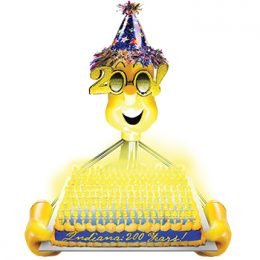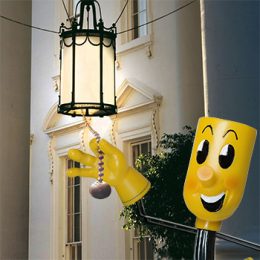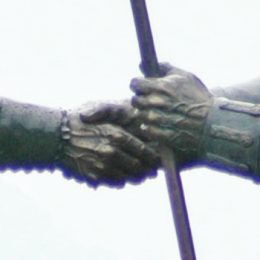 When it comes to “bright ideas,” Hoosiers have boldly brandished the torch of enlightenment to lead
When it comes to “bright ideas,” Hoosiers have boldly brandished the torch of enlightenment to lead
the nation in electrification of town and country.
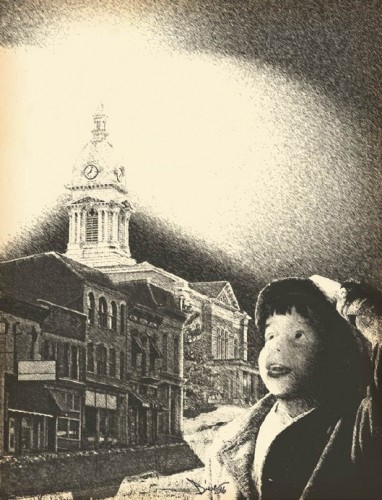
It truly must have been an effulgent “hang-onto-your-hat moment” when four arc lights for the first time began burning with blinding brilliancy from the flag staff atop the Wabash County Courthouse dome on March 31, 1880. The lights lit up the north-central Indiana town so well in all directions, Wabash earned the distinction of being the first city in the world to be fully lit by electricity. Photo illustration by Richard G. Biever
On a dark rainy night in early spring 1880, an estimated crowd of nearly 10,000 people came from near and far to the northcentral Indiana town of Wabash to witness a wondrous event billed as the dawn of a new age. Reporters from some 40 Indiana and national newspapers were on hand as were representatives of cities from Indiana and neighboring states.
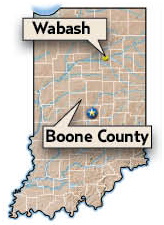 They all stood in the damp dusk, gazing toward the courthouse clock tower, waiting for 8 p.m. That’s when four new electric lights, mounted midway up the flag pole over the dome, were scheduled to, as the weekly Wabash Plain Dealer put it, “commence shedding their effulgence over the hitherto dark streets of the city.”
They all stood in the damp dusk, gazing toward the courthouse clock tower, waiting for 8 p.m. That’s when four new electric lights, mounted midway up the flag pole over the dome, were scheduled to, as the weekly Wabash Plain Dealer put it, “commence shedding their effulgence over the hitherto dark streets of the city.”
Electricity was still a novelty. Thomas Edison had successfully tested his incandescent lightbulb at Menlo Park, N.J., only six months earlier. But Wabash city leaders began investigating the possibility of lighting the city electrically and met up with Charles F. Brush, a Cleveland inventor, who had been developing electric arc lights for several years.
Arc lights used a sustained discharge of electricity in a gap between two carbon electrodes. Burning at thousands of degrees, the arc heated the tips of the electrodes making them glow with blinding brilliancy.
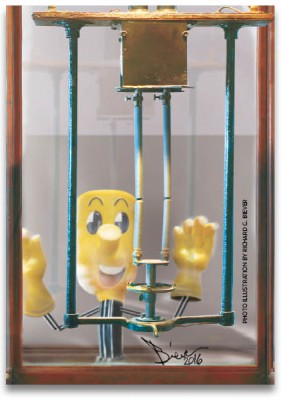
Willie Wiredhand says one of lights that made Wabash the first city in the world entirely lit by electricity is on permanent display at the courthouse.
Wabash paid Brush $100 to test his lights. They were mounted high atop the courthouse located on a hill above downtown. The courthouse dome could be seen for miles.
As the courthouse clock struck 8 p.m., a steam engine began turning Brush’s dynamo to produce the electrical charge to initiate and sustain the arc. A reporter from the Fort Wayne Daily Sentinel described what happened next: “The thousands of eyes turned toward the inky darkness over the courthouse saw a shower of sparks …, small steady spots of light, growing more brilliant, until within a few seconds, it was absolutely dazzling.”
The Chicago Tribune reported, “For a mile around, the houses and yards were distinctly visible, while the far away [Wabash] river glowed like a band of molten silver.”
The lights made Wabash the first city in the world to be entirely lit by electricity. But by 1886, a more practical system of 132 smaller incandescent lights was installed around town. In 1888, Wabash discontinued using the arc lights.
In a May 1880 article with an illustration of men harvesting giant ears of corn with ladders and handsaws, the Plain Dealer predicted the extra light falling at night would extend crop growth and revolutionize agriculture. Eventually, electricity did revolutionize agriculture, but not in the way the paper mused.
In 1935, less than 10 percent of rural America had electricity. Attempts to convince existing electric utilities to extend power lines into the countryside had been futile. Power companies maintained serving such sparse areas would be too costly.
But I. Harvey Hull, then Indiana Farm Bureau Cooperative Association general manager, knew the co-op business model could work with electric utilities, too. Small electric co-ops were already serving some parts of the country, and, on a recent trip to Europe, Hull had seen firsthand how co-ops electrified much of rural Sweden and Norway.
Hull helped draft legislation for the 1935 Indiana General Assembly — The Indiana Rural Electric Membership Corporation Act. The first bill of its kind in the nation, the REMC Act allowed for the establishment of electric co-ops to provide electricity to the unserved areas of Indiana. The bill sailed through the Statehouse, and Gov. Paul V. McNutt signed the REMC Act into law on March 9, 1935.
Indiana’s REMC Act, though, had no funding apparatus. That problem was soon solved by the federal government. In May 1935, President Franklin Roosevelt created the Rural Electrification Administration by executive order to provide loans to utilities willing to serve rural areas.
Indiana Statewide REMC (now Indiana Electric Cooperatives) was soon created by the board of the Indiana Farm Bureau as the first statewide electric co-op organization in the nation to promote local electric co-ops and provide them with engineering and other services to get them up and running. All the electrically unserved land in the state was assigned to Indiana Statewide, which then released the territory as local co-ops formed.
By the summer of 1935, Indiana Statewide was helping Indiana’s first local co-op, Boone County REMC (now Boone REMC), secure one of the first REA loans in the country.
Stay tuned each month as Willie presents more Indiana “Bicentennial Zingers.”

